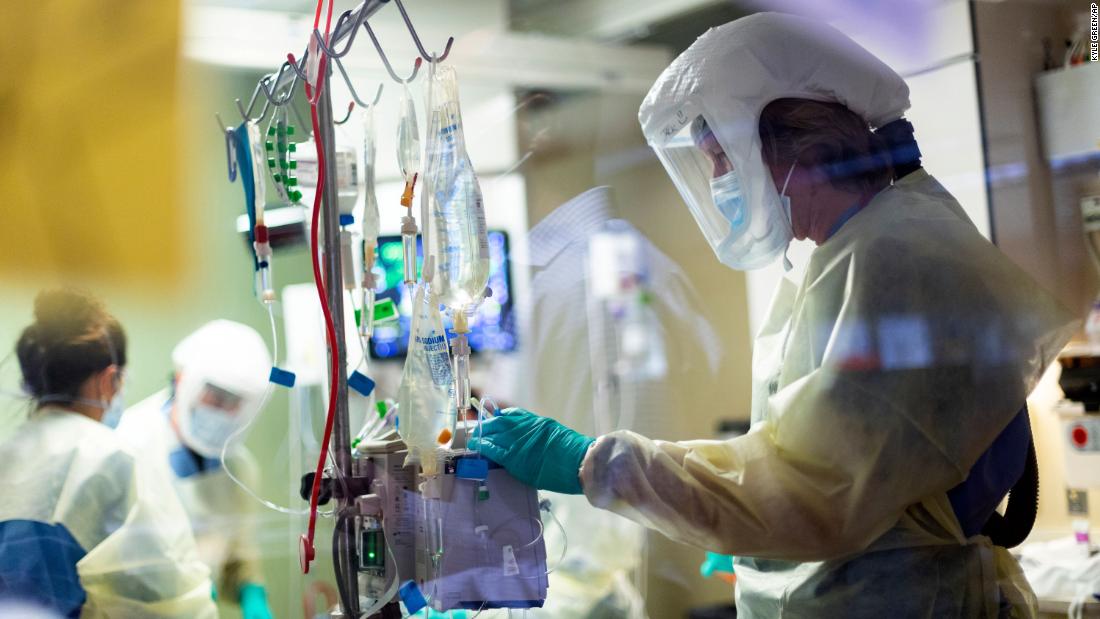Covid-19 infections are declining in the US. But hospitalizations are still high in some hotspots
The percentages of ICU beds used for Covid-19 patients in Montana along with neighboring Idaho and Wyoming are among the highest in the country, data from the US Department of Health and Human Services showed.
“Sadly, today I’m here to tell you that we’ve lost the war. That Covid is here to stay,” said Dr. Steven Nemerson,the chief clinical officer with Saint Alphonsus Health System in Boise, Idaho. “And the reason it is here to stay is because we cannot vaccinate enough of the public to fully eradicate the disease.”
The day that the first vaccine was released last December was the pandemic’s equivalent of D-Day, Nemerson said, and Covid-19 will be a recurring problem for years to come because the US failed to meet the challenge.
“There are episodes, at least on an annual basis, that we’ll have to deal with,” Nemerson said Tuesday during a briefing hosted by the state Department of Health and Welfare.
Hospitalizations at Saint Alphonsus have declined recently, Nemerson said, but that’s doing little more than giving exhausted health professionals a chance to come up for air, particularly as workers face hostility from some Covid-19 patients and families.
“None of us are superhuman, and we all have a limit to how much work we’re able to do, and how much stress and despondency we’re able to handle,” he said, “and that’s compounded by the fact that too many people are coming into our hospitals questioning what we do.”
In other parts of the country, some hospitals remain stretched thin. Alabama, Georgia, Kentucky, New Mexico and Texas have 15% or less of their ICU capacity available to Covid-19 and non-Covid-19 patients, according to HHS data.
Abiding with vaccination regulations
At Boeing, with many of its 140,000 employees working stateside, the aerospace giant announced that its US-based employees will need to show proof of vaccination or “have an approved reasonable accommodation” by December 8.
Around 31,000 inspections have been conducted, which includes installation of proper signage and checking for proof-of-vaccination, the mayor said.
Around 6,000 warnings were issued, according to NYC Small Businesses Services commissioner Jonnel Doris, yet de Blasio said only 15 businesses following the warnings were still found to be in violation and fined.
“To all the small business owners, to all the employees who made this work — thank you,” de Blasio said.
The city’s overall vaccination rate has increased by 9% since the city’s mandate began, he said.
As for public employees in other cities, approximately 812 Boston city employees are still not in compliance with the city’s Covid-19 regulations, down from 1,400 reported last week, according to a statement from Mayor Kim Janey’s office. These employees have been placed on unpaid leave.
The Los Angeles Unified School District, the nation’s second-largest, has pushed back its deadline for teachers and employees to be fully vaccinated against Covid-19 until Friday, according to a district spokesperson.
Boosters are up more than first doses, data shows
While health officials work to get as many first doses into the arms of Americans as possible, federal health data shows that the rate of boosters being administered is outpacing initial inoculations.
A preprint of a National Institutes of Health study, which has yet to be peer-reviewed or published, suggests that mixing boosters in different combinations among the three vaccines produced a robust immune response.
“The most important takeaways are two things. One is that all of these different nine combinations are safe, as in there are no new or different side effects, so all of these appear to be safe,” CNN medical analyst and emergency physician Dr. Leana Wen told CNN’s Anderson Cooper on Wednesday.
“The second big takeaway is that all of these combinations induced a pretty strong, robust antibody response. So that actually justifies the mix-and-match approach,” she said.
CNN’s Andy Rose, Laura Ly, Maggie Fox, Jen Christensen, Deidre McPhillips, Rob McLean, Alex Harring and Mallory Simon contributed to this report.
![]()


